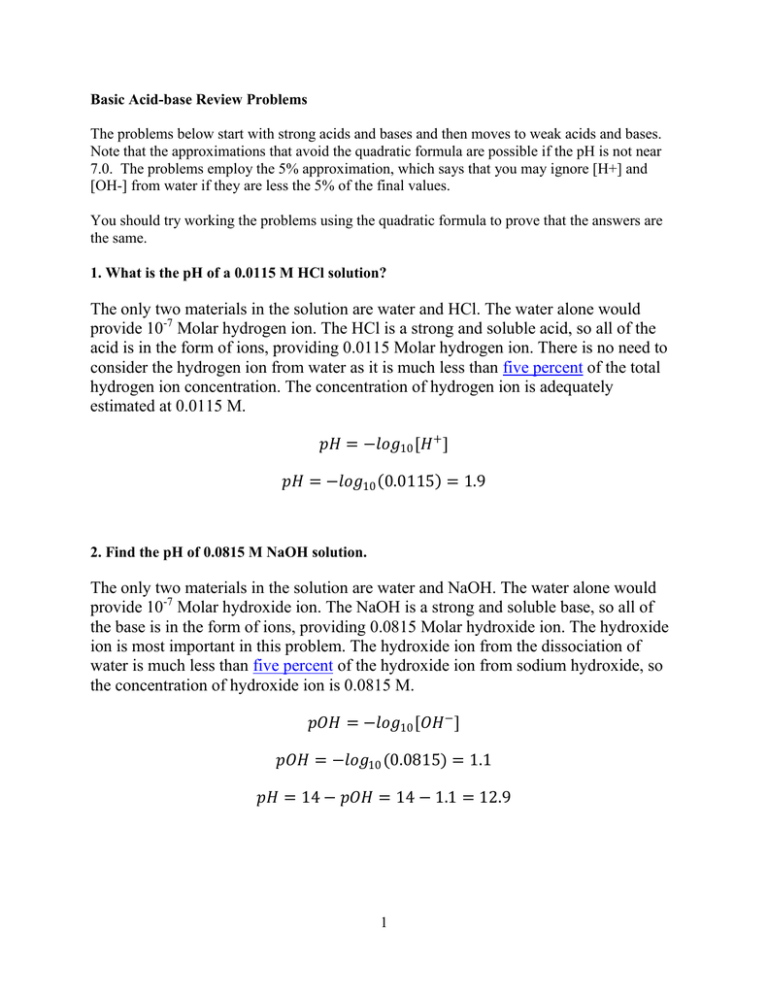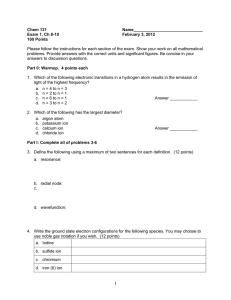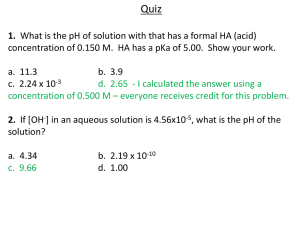1. What is the pH of a 0.0115 M HCl solution?
advertisement

Basic Acid-base Review Problems The problems below start with strong acids and bases and then moves to weak acids and bases. Note that the approximations that avoid the quadratic formula are possible if the pH is not near 7.0. The problems employ the 5% approximation, which says that you may ignore [H+] and [OH-] from water if they are less the 5% of the final values. You should try working the problems using the quadratic formula to prove that the answers are the same. 1. What is the pH of a 0.0115 M HCl solution? The only two materials in the solution are water and HCl. The water alone would provide 10-7 Molar hydrogen ion. The HCl is a strong and soluble acid, so all of the acid is in the form of ions, providing 0.0115 Molar hydrogen ion. There is no need to consider the hydrogen ion from water as it is much less than five percent of the total hydrogen ion concentration. The concentration of hydrogen ion is adequately estimated at 0.0115 M. 𝑝𝑝𝑝𝑝 = −𝑙𝑙𝑙𝑙𝑙𝑙10 [𝐻𝐻+] 𝑝𝑝𝑝𝑝 = −𝑙𝑙𝑙𝑙𝑙𝑙10 (0.0115) = 1.9 2. Find the pH of 0.0815 M NaOH solution. The only two materials in the solution are water and NaOH. The water alone would provide 10-7 Molar hydroxide ion. The NaOH is a strong and soluble base, so all of the base is in the form of ions, providing 0.0815 Molar hydroxide ion. The hydroxide ion is most important in this problem. The hydroxide ion from the dissociation of water is much less than five percent of the hydroxide ion from sodium hydroxide, so the concentration of hydroxide ion is 0.0815 M. 𝑝𝑝𝑝𝑝𝑝𝑝 = −𝑙𝑙𝑙𝑙𝑙𝑙10 [𝑂𝑂𝑂𝑂−] 𝑝𝑝𝑝𝑝𝑝𝑝 = −𝑙𝑙𝑙𝑙𝑙𝑙10 (0.0815) = 1.1 𝑝𝑝𝑝𝑝 = 14 − 𝑝𝑝𝑝𝑝𝑝𝑝 = 14 − 1.1 = 12.9 1 3. Find the pH of 0.00372 M Ba(OH)2 solution. Ba(OH)2 is a strong base, that is, up to its solubility limits the compound will be completely ionized in water solution. [(OH)-] is twice the [Ba(OH)2] because for each mol of Ba(OH)2 there are two mols of hydroxide ion. The ionization of water, the only other possible source of hydroxide ions, produces nowhere near five percent of the hydroxide ion available from Ba(OH)2, and so: [(OH)-] = 2 [Ba(OH)2] = 2 (0.00372 M) = 0.00744 M 𝑝𝑝𝑝𝑝𝑝𝑝 = −𝑙𝑙𝑙𝑙𝑙𝑙10 (0.00744) = 2.1 𝑝𝑝𝑝𝑝 = 14 − 𝑝𝑝𝑝𝑝𝑝𝑝 = 14 − 1.1 = 11.9 4. Find the pH of 0.12 M HC2H3O2 (Acetic acid) The only two things in this solution are water and acetic acid, a weak acid. The Ka of acetic acid is 1.74 x 10-5. Water and acetic acid could contribute hydrogen ion to this mixture. If water were the only possible contributor, it would give 10-7 M hydrogen ion. If the acetic acid were the only contributor, we could calculate it from the equilibrium expression. Note that this is the simplified approach that avoids the quadratic formula. It only works for cases like this where the dissociation involves a monoprotic weak acid. When in doubt, use the quadratic formula! Since the hydrogen ion from the acetic acid would be exactly the same concentration as the acetate ion, [H+] = [(C2H3O2)-]. And we can simplify by substituting [H+]2 for [H+] [(C2H3O2)-]. 2 Now we can substitute our numbers for the Ka and [HC2H3O2] to find that [H+] = the square root of (0.12 x 1.74 E-5). The [H+] due to acetic acid is 1.4450 E-3 M. The [H+] from the acetic acid is less than five percent of the [acetic acid], so there is no need to get a more accurate answer by subtracting the [H+] from the [acetic acid]. The pH is 2.84, rounded to 2.8. 5. pH of 0.255 M NH4OH The Kb of NH4OH is 1.78 x 10-5. The ionization equilibrium expression for NH4OH or any other weak base is similar to the ionization equilibrium expression for a weak acid, but this time the equation will be solved for the hydroxide ion concentration. The hydroxide ion is in excess. The two sources of hydroxide ion are the [H+] and water, but the contribution from the water is negligible. The other assumption, that the amount of dissociated ion is negligible, is also valid because the concentration of base is so large. (Try it if you don't believe it.) 3 Now substitute the numbers and do the math. 𝑝𝑝𝑝𝑝𝑝𝑝 = −𝑙𝑙𝑙𝑙𝑙𝑙10 (0.00213) = 2.67 𝑝𝑝𝑝𝑝 = 14 − 𝑝𝑝𝑝𝑝𝑝𝑝 = 14 − 2.7 = 11.3 6. Calculate the pH of 0.578 M H3PO4 In a solution that has only water and phosphoric acid there are four possible sources of hydrogen ion, the water and the three ionizations of the phosphoric acid. Each ionization has a different Ka. H3PO4 (H2PO4)- + H+ (H2PO4)- (HPO4)2- + H+ (HPO4)2- (PO4)3- + H+ first ionization second ionizaton third ionization Ka = 6.92 x10-3 Ka = 6.17 x10-8 Ka = 2.09 x10-12 It is clear that the first ionization of phosphoric acid at this concentration is much greater than the third ionization of phosphoric acid, but the big questions are whether we need to consider the second ionization of phosphoric acid or the ionization of water. The hydrogen ion concentration from the first ionization can be calculated by the usual square root of ([acid] Ka) to get an initial estimate. From the initial estimate, the [H+] from the first ionization (0.063243656 M) will be more than 5% of the acid concentration (0.578 M). We will have to use the more accurate form of the equation that includes the decrease in unionized acid concentration by the ionized forms. 4 Will we have to also account for the second ionization? The number we found as first estimate for the [H+] can also serve as estimate of the [H2PO4)-], the anion in the first ionization. But the anion of the first ionization is the original acid in the second ionization and the estimate of the [H+] can also be used in the second ionization equation. If we solve for the anion of the second ionization equation, we would get an estimate of the hydrogen ion that the second equation would produce. This is an interesting result. Notice the [H+] from the second ionization is very close to the second kA when there is nothing but water and phosphoric acid in the solution. What would happen at other concentrations of phosphoric acid? At other pH's whith the same initial concentration of phosphoric acid? The concentration estimate of the hydrogen ion from the second ionization is far below 5% of the hydrogen ion from the first ionization, so the second ionization does not need to be considered. But we do need to consider the decrease in acid concentration from ionization of the first reaction, so we use the quadratic form of the equation substituted into the quadratic equation. When you substitute the numbers, the math looks like: 5 As you can see when you do the math, the [H+] is 0.059878231, more than 5% different from the original estimate. 𝑝𝑝𝑝𝑝 = −𝑙𝑙𝑙𝑙𝑙𝑙10 [𝐻𝐻+] 𝑝𝑝𝑝𝑝 = −𝑙𝑙𝑙𝑙𝑙𝑙10 (0.0598) = 2.2 7. What is the pH of 0.16 M HCl and 0.072 M phosphoric acid? There are five sources of hydrogen ion in this solution. Count them. Water, HCl, and the three ionizations of the phosphoric acid. Likely the water and the lesser two of the three ionizations of phosphoric acid will not significantly contribute to the hydrogen ion concentration. Since the HCl is a strong acid, it contributes 0.16 Molar hydrogen ion to the solution, but the phosphoric acid is a weak acid and the [H+] from it cannot calculated by the square root of (kA [H3PO4]) because the [H+] is not equal to the [H2PO4]. We must go back to the ionization equilibrium equation for the first ionization of phosphoric acid. We can look up the Ka. The [H+] is the same as the [HCl], and the concentration of phosphoric acid is given. The [H2PO4] will be equal to the concentration of hydrogen ion contributed by the first ionization of the phosphoric acid. 6 So the pH depends only on the [HCl]. 𝑝𝑝𝑝𝑝 = −𝑙𝑙𝑙𝑙𝑙𝑙10 [𝐻𝐻+] 𝑝𝑝𝑝𝑝 = −𝑙𝑙𝑙𝑙𝑙𝑙10 (0.16) = 0.8 8. Find the pH of 1.25 M acetic acid and 0.75 M potassium acetate. Acetic acid kA = 1.74 E-5 pKA = 4.76. This is a genuine buffer problem. Added to the water are a weak acid and a salt containing the anion of the acid. There are two good ways to work buffer problems, with the Henderson- Hasselbach equation or with the ionization equilibrium expression of the weak acid or base. I personally have a mental block against the H-H equation because I can never remember whether it uses a positive or negative log and which concentration goes on top. You can use it if you wish. Particularly if you need to calculate buffers often, you should engrave it upon your gray matter. If you really need it and can't remember it, you can derive it from the ionization equlilbrium expression. There are three cautions you need to observe with either equation: (1) Make sure you are using the correct concentration for each variable, (2) check to see if the numbers you propose to use are going to be within the 5% rule for simplification, and (3) estimate the answer from what you know and make sure your final answer is reasonable. Before actually doing the problem, estimate the answer from your own reasoning. In this case, the pKa of acetic acid is 4.76. The rule is that an equimolar buffer has a pH equal to the pKa and in this problem there is less potassium acetate than acetic acid, so the pH must be lower (more acid) than the pKa within a pH unit or so. If the acetic acid were the only solute, the pH estimate would be the square root of (acid concentration times Ka). The answer should be somewhere between pH of 2.3 and 4.8 7 The majority of the acetate ion will be from the potassium acetate. Is it right that the total acetate ion concentration will be equal to the concentration of the potassium acetate? Or will the acetate ion concentration from the ionization of the acetic acid contribute more than 5%? The potassium acetate concentration is 0.75 M. The acetate ion concentration from acetic acid would be 0.00466 M, less than 5% of 0.75 M even without the common ion effect. We can safely use 0.75 as the concentration of acetate ion. Will the concentration of unionized acid be a problem? The measured concentration is 1.25 M and the ionized amount is 0.00466 M, far less than 5% of 1.25 M. As threatened, we can use the ionization equilibrium expression of acetic acid for the main equation for this problem, substituting for the kA, substituting the concentration of potassium acetate for the concentration of acetate, substituting the concentration of acetic acid, and solving for the hydrogen ion concentration to get the pH. The answer of pH = 4.5 is a reasonable one by our estimation because it is more acid than the pKa of 4.76. It is a little easier to do this problem by the Henderson- Hasselbach equation, if you are sure you know it. You must still make sure you are substituting correctly and that your assumptions for simplification are valid (within 5%). The H-H equation is not much good for solutions in which either the acid or ion concentrations are more than ten times one another or in which the concentration of either material is less than one hundred times the kA because it doesn't easily adapt to a quadratic form. 8 9




